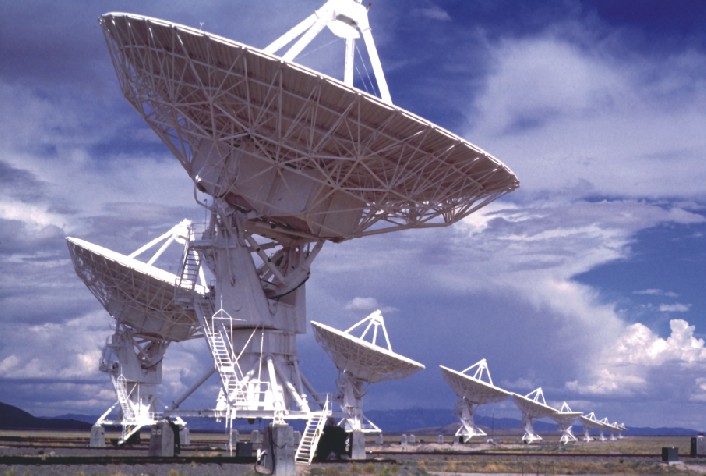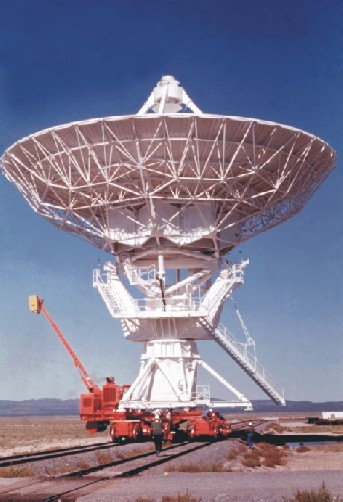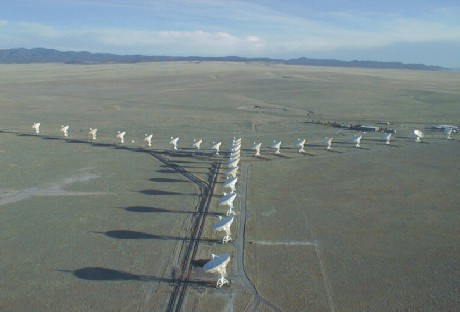

 davidstuff.com
davidstuff.com

|
|
 |
 |
A VERY LARGE ARRAY The Very Large Array (VLA) is one of the world's premier astronomical radio observatories. The VLA consists of 27 antennas arranged in a huge Y pattern up to 36km (22 miles) across -- roughly one and a half times the size of Washington, DC. Each antenna is 25 meters (81 feet) in diameter; they are combined electronically to give the resolution of an antenna 36km (22 miles) across, with the sensitivity of a dish 130 meters (422 feet) in diameter. History: 1972 August: approved by Congress 1973 April: construction started 1975 September 22: first antenna put in place 1976 February 18: first fringes 1981 January: entire array completed nearly one year ahead of schedule! The total cost was $78,578,000 (in 1972 dollars), roughly $1 per tax-payer at the time; the project was completed within the allotted budget. Location: Plains of San Agustin, west of Socorro, New Mexico. latitude = 34 04' 43.497" north longitude = 107 37' 03.819" west elevation = 2124 m Size: Each antenna: 25m (81 ft.) in diameter, 230 tons. The array: There are four configurations: A array, with a maximum antenna separation of 36km; B array -- 10km; C array -- 3.6km; and D array -- 1km. The telescopes are switched between these configurations every four months or so. Resolution: 0.04arcseconds The resolution of the VLA is set by the size of the array -- up to 36km (22 miles) across. At our highest frequency (43GHz) this gives a resolution of 0.04 arcseconds: sufficient to see a golf ball held by a friend 150km (100 miles) away. Of course, very few golf balls contain high-power radio transmitters... Misc. antenna information: Slew rates: 40 degrees per minute in azimuth, 20 degrees per minute in elevation Minimum elevation angle: 8 degrees above the horizon Frequency coverage: The VLA can observe at various bands between 300 and 50,000 MHz (90 to 0.7cm): How does it work? The VLA is an interferometer; this means that it operates by multiplying the data from each pair of telescopes together to form interference patterns. The structure of those interference patterns, and how they change with time as the earth rotates, reflect the structure of radio sources on the sky: we can take these patterns and use a mathematical technique called the Fourier transform to make maps. Who uses it? The VLA is used primarily by astronomers from around the world. It's also occasionally used for atmospheric/weather studies, satellite tracking, and other miscellaneous science. If you would like to use the VLA for your research experiment, please see the instructions for submitting proposals . Who runs it? The VLA is operated by the National Radio Astronomy Observatory (NRAO), which is a facility of the National Science Foundation (NSF), operated under cooperative agreement by Associated Universities, Inc. (AUI). Can I go see it? The VLA is open to the public. For more information , visit the VLA home page here: https://public.nrao.edu/ Visit the National Radio Astronomy Observatory here: https://public.nrao.edu/telescopes/vla/  Comment: All of this technical data and jargon are important to scientists. I really do not understand it. For the common person, this is a sight to behold. It is overwhelming. In June of 1983 I was touring the State of New Mexico on my motorcycle and while traveling east on Highway 60, I could see some kind of man-made structure on the plains several miles ahead. As I drew closer, I could see the object was enormous. Soon I could see that it was several objects and eventually the whole Array was visible. I had no idea the Array was there, what it was or for what purpose. The site seemed abandoned and the one road going into the site had a padlock on the gate. At the gate was a small (1ft x 2ft) metal sign on a wooden post that said simply "A Very Large Array.” I have seen several man-made structures that made me stand in awe, they include the World Trade Center, the Empire State Building, Hoover Dam, the Mackinac Bridge and the Golden Gate Bridge. This Array however, took my breath away. It was eerie. Chilling. Almost sinister. Unfortunately, the site is not on the way to anywhere and the area is sparsely populated so you probably will never see it. The pictures above do not convey the enormity of the project. This is a personal experience. David  |
|
|
|
Nation Visitors Since March 8, 2013